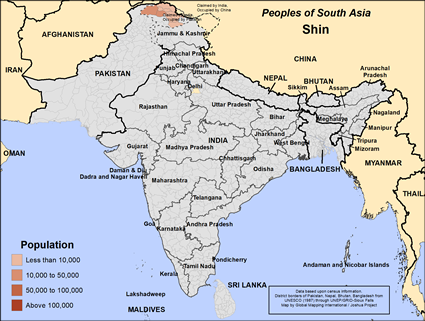Shin in Pakistan

Photo Source:
Zaheer Abbass Dardistani - Wikimedia
Creative Commons
|

Map Source:
People Group data: Omid. Map geography: UNESCO / GMI. Map Design: Joshua Project
|
| People Name: | Shin |
| Country: | Pakistan |
| 10/40 Window: | Yes |
| Population: | 43,000 |
| World Population: | 43,000 |
| Primary Language: | Shina |
| Primary Religion: | Islam |
| Christian Adherents: | 0.00 % |
| Evangelicals: | 0.00 % |
| Scripture: | Portions |
| Ministry Resources: | No |
| Jesus Film: | Yes |
| Audio Recordings: | Yes |
| People Cluster: | South Asia Muslim - other |
| Affinity Bloc: | South Asian Peoples |
| Progress Level: |
|
Introduction / History
Northern Pakistan, bordered by China to the north, Afghanistan to the northwest, and India to the east, is said to contain the most breathtaking sights in Pakistan. It is there—nestled between five of the world's highest mountain peaks—where Pakistan's northern tribes live. They are the original inhabitants of the area.
The northern tribes include the Badeshi, Burushas, Kolai, Punjabi Pahari, Shumashti, Kho and the Shin (AKA, Shina). Before they were conquered by the Pashtuns, their ancestors occupied Dir, Swat, and other areas of northern Pakistan. The British gained control of the region around 1895 but left in 1947 when Pakistan became an independent nation. The northern tribes are known as quiet, peace-loving, and brave people. Most of them live in the upper valleys, where farming is very difficult due to the dry, rugged mountain terrain. The opening of the Karakoram Highway, which follows the Indus River Valley, has had a great economic impact on this region.
The Shin people have their own language with dialects such as Brokskat.
What Are Their Lives Like?
The Shin people are primarily farmers and shepherds. They plant grain on terraced fields and use oxen for plowing. In the remaining area, which is very dry and irrigated by glacial runoff, they raise barley, wheat, maize, millet, and rice, supplemented by potatoes and a variety of other vegetables. Since they can only grow one annual crop, the people rely on the "transhumant" herding of their dairy goats and cattle. This means that they transfer their livestock from one grazing ground to another with the changing of seasons. During the summer months, they leave their permanent villages and drive the cattle, goats and sheep to alpine pastures.
Mountain ranges and political borders tend to isolate the ethnic groups that live in the northern areas. Most settlements exist as small independent communities, located at altitudes between 2,000 and 14,000 feet. Families usually have houses in four or five different locations at the higher altitudes. Only in the winter do they live together in their compact villages, which lie along the rivers.
Prior to the twentieth century, the northern areas of Pakistan were semi-independent. They were under various local rulers. Today these communities are under Pakistani administration, governed by a federally appointed district commissioner.
Ever since the abolition of certain local rulers, the northern tribes have undergone many social and cultural changes. Although an extensive road-building project is providing them with greater access to the mainstream of Pakistani society, it is also encouraging the influx of the dominant Pashtuns from farther south. Among the smaller ethnic groups, there is a growing resentment toward the Pashtuns, who dominate the district government.
The Shin and other tribal groups in the northern territories practice endogamy, meaning that they only marry within their own group. Their societies are also patrilineal, which means that the line of descent is traced through the males. The women are not secluded, as is customary among many other Muslim groups, because they are needed to help with the farm work.
What Are Their Beliefs?
Centuries ago, the area of northern Pakistan was primarily Buddhist. Later, Buddhism was replaced by Hinduism. However, around 1000 A.D. , the Islamic faith spread to the region. Today, the vast majority of the people are Sunni Muslim. Traces of traditional, pre-Islamic beliefs still linger for many of them. Some of the tribes practice shamanism. Members of these tribes believe that there is an unseen world of gods, demons, fairies, and ancestral spirits. They depend on shamans (priests or priestesses) to cure the sick by magic, communicate with the gods, and control events.
What Are Their Needs?
The northern tribes have many health problems due to poor water quality and poor nutrition. Portable drinking water, sewage disposal, and drainage facilities are only available for a small segment of the population. Dentists and doctors are desperately needed among these groups. Educational facilities are also lacking and the need for qualified teachers is great.
Prayer Points
Pray for gospel materials like the JESUS Film and gospel recordings to become widely distributed in this part of Pakistan.
Pray for a Holy Spirit-driven spiritual hunger among the Shin people that will only be satisfied by Jesus Christ.
Pray for a family-based movement to Christ among the Shin people of Pakistan.